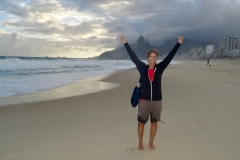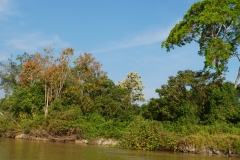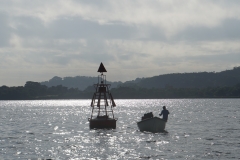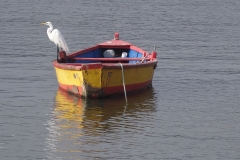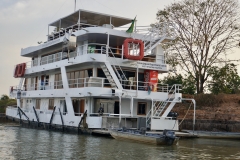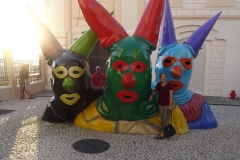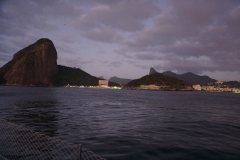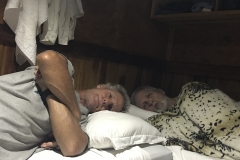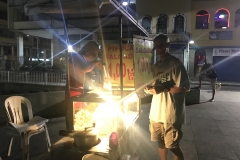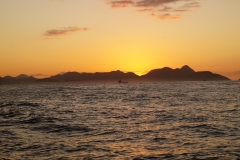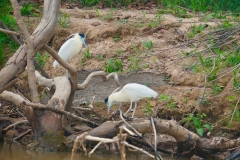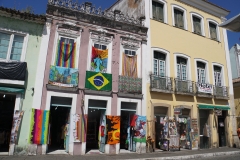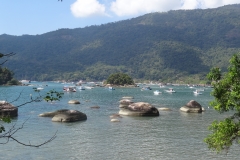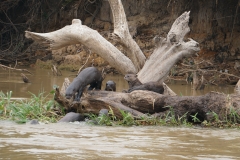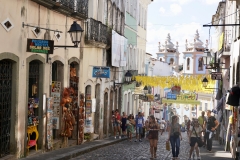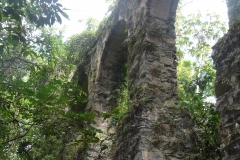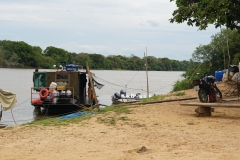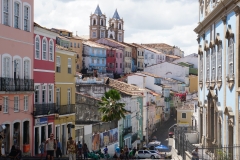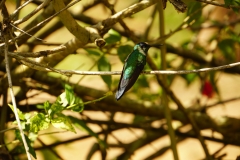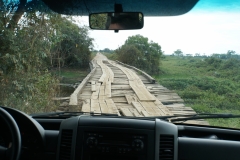Cindy, John, and I returned to Pazzo in Antigua and sailed 18 days to the NE tip of Brazil where we found the small, lovely resort island of Fernando da Noronha. Our course took us along the north coast of South America, past Guyana, French Guyana, Surinam, and the Amazon River delta of Brazil. The trip was long, but with only a few difficult days. Mostly, just slow going with wind and current against us.
At 18 days, this was Pazzo’s longest passage under our ownership. With wind and current against us, progress was slow, but mostly pleasant. We did have a few difficult days with passing weather systems and foul rivers of current. We also had an unusual number of problems with chafe. We broke a jib halyard only a few hours out of Antigua. This was due to a change I made to the halyard connection at the head swivel. Next came a broken mainsail leech cord, caused by a ridiculously sharp edge on a block affixed to the headboard of the mainsail. Additionally, we broke several batten boxes (attaching the front end of the batten pockets to the roller bearing mainsail slides) and chafed thru a couple of batten pockets at the leech. Disappointing details for a new mainsail. We took these challenges in stride, overcoming one at a time.
Noronha is about 200 miles off the NE corner of Brazil. Few American yachts visit the Island, and Brazil, for that matter, because the route from the Caribbean is challenging. Most visiting yachts are coming from Europe along the route sailed by the old square-riggers and slave traders. The island is about the size of Vashon Island and is noted for it’s beautiful beaches, good food, and friendly inhabitants. It is also very expensive. We paid $150/day for the privilege of anchoring in their one bay and putting 3 pairs of feet on their sand.
To see the island and find all the delightful beaches, we rented a “boogie” (Dune Buggy) with a gutless little VW engine but excellent suspension – necessary to get along with the terribly muddy and rutted roads.
After 5 days of rest, fixing the boat, and exploring the island, we set sail for a miserable 2-day bash to Recife, Brazil’s 3rd largest city (after Rio De Janeiero and Sao Paulo). In Recife, we made new friends, stayed in a nice yacht club, ate good food, and started our relationship with Brazil’s various homeland security officials.
Like many countries we’ve visited, Brazil is drowning in bureaucracy and terrible inefficiency. The officials we’ve met are generally friendly and helpful, but their system is onerous. Yachts and crews are required to check in and out with the Port Captains in each port that has a Capitania Dos Portos. Mexico has the same requirement, although few yachts comply. On the advice of one of our Guide Books, we’ve adopted a policy of checking in with the Capitania Dos Portos only in the first port of each state we visited.
Brazil is comprised of 26 states (like the USA), each with its own flavor… and bureaucracy. Each state wants to follow the movements of yachts and crews. They want to know who’s entering and who’s leaving – hence the check-in and check-out rules.
After Recife, we sailed south to Bahia de Salvador, geographically, Brazil’s largest and best natural harbor offering several port facilities scattered around “Bahia.” Pazzo spent a week exploring the various anchorages around Bahia and enjoying the hospitality of the Iate Clube de Aratu (deep in Bahia), and the municipal marina near the entrance to the bay. Salvador was Brazil’s first capitol and has a well restored old colonial center known as “Pelourinho,” where we found stately plazas, quaint restaurants, scores of B&Bs (Pousadas) and lively nightlife. Pelourinho is the tourist center of Salvador and overlooks the municipal marina. Every evening we rode the elevator from the lower City up to Pelourinho where we bought 25-cent popcorn before and after dinner. The vendor appreciated our 25-cent tips ☺. We were sad to see John head back to the States to take care of his many commitments in Seattle and California.
Next on our adventure, we sailed south along the Atlantic coast, stopping for a few days at Camamu, a quaint collection of towns and anchrorages up the Rio Marau. Next stop was at Arquipelago Dos Abrolhos, a charming and quiet collection of islands and natural park known for frequent humpback whale visits and it’s seabird colonies, and then on to Vitoria, the capitol of Espirito Santo State.
We spent 4 nights in Vitoria, waiting for favorable weather to continue South. The highlight of our stay in Vitoria was meeting and making new friends with Floris and Ivar, two kind and able Dutchmen sailing “Lucipara II,” a sturdy steel Ketch from Amsterdam. Lucipara is the first southbound yacht we’ve met since leaving the Caribbean! It is fun to meet and share experiences along our similar tracks! And, Ivar makes a mean Dutch Apple Pie!! Move over Winkel (famous pie shop in Amsterdam).
On August 29, we got an early start on our leg south to Rio De Janeiro with stops at Buzios, a tiny tourist trap made famous by Bridget Bardot in the 1970s, and Itaipu, a small anchorage just outside of Rio with a beautiful beach PACKED with Brazilian weekend beach-goers. As luck would have it, we awoke in Itaipu to a “dug-out” canoe regatta and much festivity!
The following day, we motored into the awe-inspiring harbor of Rio de Janeiro in the shadow of towering sugarloaf rock and under the watchful eye of Christ the Redeemer. Our hosts at the Charitas Marina extended a warm welcome, sending a couple of helpers out to Pazzo to “help” with med-mooring (stern-tying) to their well-maintained dock. Following much confusion, sketching, and discussion in broken Portugese, we took control and got the boat well secured. Cindy’s brother-in-law, Bruce Luscombe, joined us here for some coastal cruising and subsequent inland adventures.
No visit to Rio would be complete without visits to Christ the Redeemer and Copa Cabana and Ipenema beaches. Despite the drizzly weather, Cindy scored the requisite pictures of these iconic landmarks and we enjoyed grilled shrimps at a beach-front lunch bar.
From Rio de Janeiro, we sailed south to Ilha Grande and the lovely cruising grounds of Paraty and Angra Dos Reis. This group of bays and Islands are very much like a down-sized San Juan Island group. Warm water for swimming, calm anchorages. Great hiking, and very friendly locals.
We spent a week or so exploring all the nooks and crannies of the Ilha Grande area before pushing south to Ilhabela, a quiet upscale island with a welcoming yacht club where we could leave Pazzo on a secure mooring for a few weeks while we bussed to the colossal city of Sao Paulo to catch a flight to Brazil’s interior for some tourist fun.
Cindy, Bruce, and I spent a bit over two weeks visiting Brazil’s Pantanal swamplands, the Bom Jardin Lakes area, and the Cataratas Iguacu (Waterfalls). The Pantanal is South America’s best and biggest large animal playground – better than the Amazon Jungle! On our 4-day tour, we spotted 8 large Jaguars, a giant anaconda, countless capybaras (world’s largest rodent) and caimans (alligators), and a large array of birds including toucans, storks, and mckaws. The wildlife was astounding but the fishing was disappointing. We caught only one small piranha, but he was tasty when the lodge fried him up for us. After the Pantanal, we returned to Cuiaba and on to Bom Jardin, a region in the middle of Brazil known for its waterfalls and crystal clear streams. Here, we enjoyed floating down the river and swimming with a variety of fresh water fish. We were overwhelmed by the warm hospitality of locals. Sure, they are catering to tourists like us, but they were genuinely happy to host us and went well beyond expectations to make sure we enjoyed their special corner of Brazil.
Following Bom Jardin, we caught a flight to Foz de Iguacu – thru Sao Paulo, of course, as all flights in Brazil seem to flow thru at least one of Sao Paulo’s four airports. Staying at a lovely and convenient Pousada (B&B) near the entrance to the Brazil side of the park, we got the full Iguaco experience. The Brazil park is much smaller than Argentina’s park, but offers better panoramas to take in the full scope of the Cataratas (Falls) – over 250 in all. The busses into the park were hopelessly inefficient and disorganized causing long delays… but, hey, we had all day. Our day in Argentina, started with a taxi ride across the Argentine/Brazil border. The taxi delivered us to the large Argentina Iguacu park where a plethora of well built and maintained walkways allow visitors a “very personal” experience with many of the falls. Standing atop the viewing platform on the rim of “Devil’s Throat” was truly awe-inspiring. While the weather wasn’t cooperative (cloudy and drizzly), our visit to Iguacu was nothing short of incredible. Put this on your bucket list.
We parted company with Bruce after Iguacu with Cindy and I returning to Pazzo in Ilhabela on October 2. We found her in good condition, waiting happily to continue our southbound adventure together… with newly repaired spinnaker and furler, thanks to Gabriel and his able team at North Sails Brazil.
After a short one-day sail to Ilha Bom Abrigo, we continued on to Bahia Paranagua in search of bright red Scarlett Ibises. We saw these flaming red birds in an amazing aviary in Iguacu but really wanted to find them in the wild. Unfortunately it wasn’t to be. So, after a couple of days hunting Ibis in the mangroves and hiding from southerly winds, we continued southward to Itajai where we planned to rest a few days and visit Chico and Jacqueline, dear friends of Mario, Marcos, and Marina, our Brazilian friends whom we met in Puerto Rico.
Well, the weather gods had different ideas for us. As it became clear that our 2 – 3 day stop-over in Itajai would extend to a week or two, we made an executive decision: Rather than wait in Itajai before proceeding south to Buenos Aires where we had planned to haul the boat for bottom paint and projects, we’d haul the boat in Itajai at a very nice boatyard and have the bottom work done while we returned to Seattle for a home visit. So, we bought bottom paint, hired the boat yard to do the work, bought air tickets, and lifted our gal the next day. Because the yard was fresh out of jack-stands to support the boat on the hard, they set the boat in the cradle of a much larger yacht, well supported but high off the tarmac. We weren’t thrilled with the arrangement, but it worked out alright.
After 10 days split between Seattle and San Francisco (to see Mom), I returned to Pazzo to take care of a number of out-of-the-water projects before Cindy’s return a few days later. Sadly, I was reminded, on my return, of the old adage: “If you want a job done right, do it yourself.” The contractor we hired had an array of excuses why our project was behind schedule and it wasn’t clear that he had followed my or the paint manufacturer’s application instructions. The worker he had hired to apply our paint was an Uber driver trying to make a few extra bucks on the side. Delightful but inexperienced. Add to this a few mis-communications between the workers, the yard manager, and the contractor and you can see that the whole affair was a bit of a cluster. For the boat owner who is actively involved in all aspects of the haulout and projects, Itajai Marina is a great option. For those looking for a turnkey solution, we suggest you look elsewhere.
Cindy arrived in Itajai on October 28, just in time for Brazil’s historic presidential vote where the populace voted out the corrupt regime that has driven the country to financial ruin and installed Bucellero, widely considered a “nut-job”, in a desperate move to turn the country around. As in America, many Brazilians are frustrated by their lousy presidential options. Where are all the truly great leaders? Nevertheless, it was exciting to be part of this important moment, filled with hope for a brighter future. After a couple of days finishing projects, paying bills and provisioning, we sailed south to Florinapolis where we met Italians Anna and Paulo on “Zoomax,” a very quick French aluminum 52 footer. We shared a few anchorages with Anna and Paulo, including one very windy afternoon where we recorded a gust of 54 knots. We love our Spade anchor which held us securely for several hours as the local system ran its course and finally blew itself out. We spent only a day in Florinapolis, shopping and completing paperwork (immigration, customs, and port captain) necessary to check out of Brazil. We would have liked to explore Florinapolis a bit, but when the weather gods offer a suitable window to sail south, one must grab it.
We departed Florinapolis on November 2, and, after comparing weather notes with Zoomax, sailed 500 miles (3 days) south along the coast of southern Brazil, across the border with Uruguay, and into the quiet and beautiful tourist trap of Punta Del Este.
